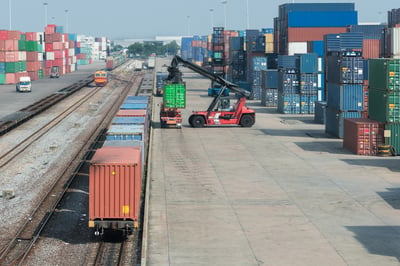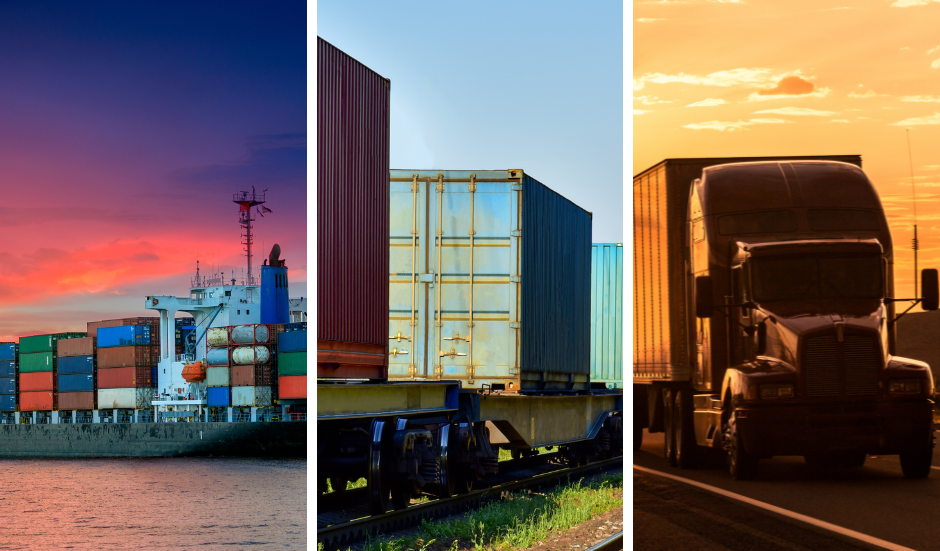What does an efficient freight operation look like? Is efficiency getting the product to its destination on time? Or is it cost efficiency? Or is it minimizing your carbon footprint? The short answer, of course, is that a company can define freight efficiency in any number of ways. As freight industry experts, let’s take the idea of efficiency from an intermodal logistics view.
One rule of efficiency governs most shipping transactions: you pay for what you get. Fork out a lot, and you’ll get your product there quickly and reliably. Pay a pittance, and your project will get there eventually… hopefully. The trick, for the vast majority of customers, is to find a good middle ground between price and quality of service. And, of course, it’s this Goldilocks Zone that a good supply chain management team will work to make happen for you. One of the strategies you may encounter on your journey to improved supply chain efficiency is a concept known as intermodal transport.
What is this catchily labeled thing?
Should you care about it?
Why?
In this blog, we’ll tackle intermodal transport head-on. We’ll give you a 101 overview of what it is, why it’s (sometimes) good, why it’s (sometimes) not useful, and how to get started if you’re interested in taking the intermodal route.
Intermodal transport 101
Intermodal transport is a mode of logistics in which freight is transported using multiple modes of transportation, including road, rail, ocean, and air. Crucially, intermodal should entail minimal additional freight handling while changing modes.
Intermodal is also frequently used interchangeably with multimodal logistics. The difference lies in the carrier. Intermodal typically involves a switch of the carrier, especially when jumping to another mode. However, multimodal is usually regaled to conversations where a single carrier oversees and is responsible for the entire shipment regardless of mode, such as working with FedEx Ground and Air to cover a particular load.
Before going any further, it’s worth acknowledging that intermodal transport has become a popular alternative. Drawn to its mystique in logistics circles, companies are asking questions about intermodal, eager to learn more about its potential. Freight brokers and 3PLs have been equally eager to jump on the bandwagon, advocating intermodal as the new gold-plated holy grail for your supply chain configuration.
Here’s our first free chunk of advice regarding intermodal: Don’t believe the hype.
The age-old rule of snake oil remedies applies here. If a slick salesy type told you that their magical elixir cured lumbago, warts and baldness, you’d probably slam the door in their face … and it wouldn’t matter how many free steak knives or deluxe tomato juicers they threw at you to sweeten the deal. The same applies here. Intermodal transport solutions do have a place in supply chain management, but it isn’t some miraculous solution that automatically saves you money or effortlessly fixes a busted supply chain.
Intermodal is just one potentially useful tool among many possible solutions. It may work for your business, but it’s smart to do your research and talk to a trusted 3PL before diving headlong into azure intermodal waters.
Why intermodal freight?
 Intermodal is typically viewed as trucks and trains, but it’s much more than that stereotype. Domestic intermodal can help to move freight coast to coast, and you can even get more complex with cross-border intermodal freight. The trick is to understand what you need from the final delivery and whether you can leverage intermodal to get there on time.
Intermodal is typically viewed as trucks and trains, but it’s much more than that stereotype. Domestic intermodal can help to move freight coast to coast, and you can even get more complex with cross-border intermodal freight. The trick is to understand what you need from the final delivery and whether you can leverage intermodal to get there on time.
Intermodal logistics come into play as a way to get granular about balancing speed and reliability against cost. It’s an approach designed to deliver the best of many worlds. Here are a few scenarios where intermodal transport can be beneficial.
- Managing shipping uncertainty: Intermodal transport diversifies how you move your product around. Let’s say you ship a time-critical product. If you relied exclusively on rail, for example, a rail strike could cripple your shipping operation. If you relied solely on trucking, the dwindling buying power of shippers might gradually box you into suboptimal solutions. Intermodal solutions better position your company to pivot when something unexpected happens. Plus, intermodal can mean adding air to the mix, so it’s naturally going to come up with expedited or express items too.
- Intermodal can be resource efficient: Resource efficiency is more than a vague ethical concern — it’s the future. The SEC is currently pushing a ruling where some companies must report on the carbon footprint of production and distribution, including their supply chain. And this is only the thin leading edge of a wave of reforms impacting shipping in the US and the world at large. Intermodal transport can significantly reduce emissions by leveraging energy-efficient transportation modes where possible. Consumers are increasingly demanding resource-efficient supply chain practices.
- It can also be cost-efficient: All things being equal, if you can transition from road to rail for a meaningful part of the voyage, you’ll typically realize significant savings on freight costs. Further cost efficiencies can be gained by leveraging a variety of trucking modes best suited to your freight, its journey, and your customers’ expectations. It’s important to note, however, that switching modes isn’t always the most cost-efficient approach. Its fuel efficiency is usually a core value prop, but it could easily add to the complexity of the shipment; we’re talking rail ramps, staging and more. Intermodal tends to be sold as an inherently cheaper solution, which considerably overstates reality. It’s easy to lose efficiencies on drayage (the transport of goods over a short distance to connect different modes of shipping). You may also encounter unexpected and costly practical complications from using multiple channels for a freight line. It’s important, therefore, that you measure the cost efficiency of intermodal transport on a case-by-case basis.
- Intermodal helps you capitalize on flexibility: For example, let’s say your business model and product routinely afford you considerable delivery time flexibility. Intermodal can work in your favor here by giving you the option to choose slower, more time-variable shipment methods.
When and where intermodal service falls short
As we said near the beginning of this blog, intermodal transport is the flavor of the month. As 2022 rapidly ticks down to 2023, many 3PLs and freight brokers are touting the approach as some kind of inherently superior solve-all approach. This isn’t accurate. Let’s look at a few scenarios where intermodal makes less sense.
- Shorter routes: Optimal mileage varies across regions, but generally speaking, intermodal transport makes no financial sense for routes shorter than 500 miles. This is especially true considering the extended length of rail transportation networks. Intermodal requires active management, close surveillance, and regular analysis. These activities cost you extra time and money. At short distances, that extra outlay isn’t sufficiently offset by reduced transport costs.
- Reliance on complex drayage: Depending on where you’re located and what you’re transporting, your intermodal freight operation may require complex drayage arrangements. For example, if you ship temperature-sensitive items, you may require a drayage service with specialized equipment and round-the-clock availability. Such services are exorbitantly priced and will rapidly erode the savings you might otherwise have realized using intermodal transport. For intermodal to work, your drayage needs to be over a short distance, uncomplicated, and in a geographical area where reliable drayage services operate.

- If you already have purchasing power: The purpose of intermodal is to find a competitive and efficient solution drawing from multiple shipping channels. The old rule still applies, however, that the best solution is a simple one. If the shipping market is in your favor — whether owing to supply and demand or having a regular, reliable high shipment volume — you have a lot of leverage up your sleeve to demand a value-for-money service from a stable of reliable conventional carriers.
- If reliability is a critical factor: Intermodal transport may not be able to deliver the clockwork efficiency you require if you ship to clients with tight delivery requirements — for example, an e-commerce agent or an industry like automotive where production lines are heavily dependent on timely deliveries. If entire production lines depend on a shipment arriving on time, it’s usually best to simplify your supply chain, choose reliable suppliers, and build a strong relationship with them over time. A managed transportation provider can help you achieve more reliability by auditing shipments, tracking arrivals, rapidly triaging shipment problems and seeking out ways to continuously improve your shipping process.
- If you lack access to intermodal expertise: Transitioning to intermodal isn’t as simple as adding and joining more dots to optimize your supply chain. Take weight calculation as one example: The optimal weight of an intermodal container shipment typically varies considerably from a conventional container shipment. Moreover, shipments move differently depending on the modes of transport you employ, so as you transition to intermodal, you may need to brace and pack your materials differently to avoid damage in transit. The point is, that intermodal adds a high level of complexity to your supply chain. That’s why it’s important to work alongside a trusted supply chain adviser who can routinely perform granular audits of your shipments, set SMART goals, and help you implement the required changes.
Fast-track your use of intermodal with IL2000
So … intermodal. Is it a fresh new modality with true potential to improve your supply chain? Or is it just more of the same with a dash of extra marketing hype? Here’s IL2000’s take: Intermodal transportation is a good option for lowering supply chain costs and adding some extra resiliency to guard your freight operation against supply chain volatility. But there are a few caveats. You need to be shipping at longer distances, within a relaxed delivery time window, and with a strong shipping team to help you make it work. For added confidence, work with an expert team that can offer 24-hour logistics support.
Ultimately, intermodal is just one tool in a subtle and ever-growing supply chain management toolbox. Our advice is not to choose a 3PL purely because they emphasize their intermodal logistics skillset. Instead, focus on the outcomes you need to achieve and the 3PL’s track record in delivering those outcomes.
There’s no magic button to get the right mode for every shipment, not in the literal sense. The next best thing is to have a team on your side. IL2000 is that team. We’ll conduct a full, no-obligation freight analysis and offer expert advice on whether an intermodal solution makes sense, how to set performance measurements, and how to evaluate your results over time.
Get the shipment rolling here.
Want to get in touch right now? Fill out the form below!

